Victorian-era engagement rings, a timeless embodiment of romance and sentimentality. Delicate floral motifs, tender hearts, and the enchanting language of acrostic messages intertwine to craft symbols of enduring love. Step into the opulent world of this captivating engagement ring style.
The Victorian epoch, a period steeped in elegance and grace, takes its name from the illustrious Queen Victoria (1819–1901), whose reign over Great Britain spanned nearly six decades, from June 20, 1837, to May 1, 1901. Throughout her tenure, this beloved monarch’s refined tastes cast a profound influence over art, fashion, and societal norms. Revered for her timeless elegance, Queen Victoria set trends that transcended borders and generations. The fragrant orange blossom wreath adorning her bridal ensemble became the epitome of bridal fashion, inspiring brides across Britain. Her exquisite jewelry, often showcased in newspapers of the day, served as a beacon of opulence and sophistication, sparking widespread emulation among the fashion-conscious elite.
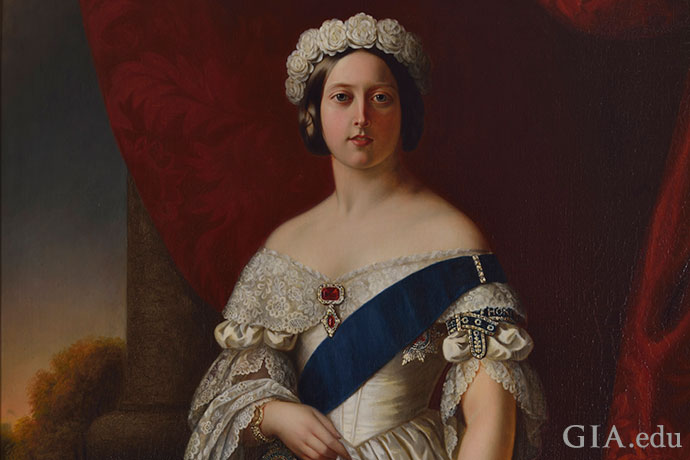
Enter the regal world of Queen Victoria, adorned in resplendent jewels and regal regalia, as captured in this exquisite portrait by Alexander Melville from 1845. Courtesy: www.bildindex.de, obj 13850883, via Wikimedia Commons
The illustrious union of Queen Victoria and Prince Albert, though fleeting at 21 years, was a love affair immortalized and revered by an enamored public. Amidst the splendor of their courtship, Albert’s untimely demise from typhoid in 1861 plunged Queen Victoria into a lifelong state of mourning, yet their enduring love remained etched in the annals of legend.
Queen Victoria’s jewel-studded collection bore testament to her multifaceted persona, from a serpent bracelet symbolizing the “wisdom of the serpent” befitting her regal stature, to treasured relics reset from the Crown Jewels. Adornments such as a heart-shaped locket containing strands of Prince Albert’s hair, worn as a poignant tribute after his passing, and the resplendent sapphire and diamond diadem, showcased her enduring devotion.
Of particular significance were the jewels bestowed upon her by Prince Albert, often bearing his own exquisite designs. A sapphire and diamond brooch, gifted to her on their wedding day, graced her bridal portrait with regal elegance. Over time, in homage to the floral tiara she wore during their nuptials, he presented her with a series of exquisite pieces inspired by the delicate orange blossom motif.
In the wake of Prince Albert’s passing, mourning jewelry, characterized by somber hues of black enamel, jet, and onyx, became the sartorial norm across England. Yet amidst her mourning garb, diamonds continued to sparkle as beacons of enduring elegance, adorning Queen Victoria’s attire in a poignant display of timeless sophistication.
Against the backdrop of Queen Victoria’s six-decade reign, marked by unprecedented advancements from anesthesia to railways, a burgeoning middle class enjoyed newfound prosperity, fueling a renaissance in jewelry acquisition. The discovery of vast diamond deposits in South Africa in the late 1860s democratized access to these coveted gemstones, once the exclusive domain of the aristocracy.
As the era unfolded, a plethora of distinctive motifs emerged, ready to be immortalized in bespoke Victorian-style engagement rings, each a timeless testament to the romance and elegance of a bygone era.
Victorian Style Engagement Rings: Secret Messages
In the opulent realm of Victorian adornments, acrostic jewelry reigned supreme, weaving clandestine messages through the subtle interplay of gemstones. A symphony of precious stones, meticulously arranged to spell out endearing sentiments, transformed ordinary adornments into vessels of profound emotion.
Take, for instance, the enchanting allure of the word “Regard,” delicately encoded within a tapestry of ruby, emerald, garnet, amethyst, ruby, and diamond. Such clandestine compositions, veiled in the language of gemstones, whispered messages of affection known only to the hearts entwined in love’s embrace.
Within the cherished lexicon of acrostic terms, “Adore,” “Dear,” and “Dearest” stood as luminous beacons of devotion, while birthday wishes blossomed into tangible expressions of affection. Each gemstone, imbued with its unique symbolism, became a vessel for the unspoken desires of the enamored.
In the realm of bespoke Victorian-style engagement rings or wedding bands, acrostic jewelry emerges as a quintessential choice, offering a canvas upon which the most intimate sentiments can be etched in stone. A personalized masterpiece, crafted with care and adorned with hidden messages, becomes a cherished heirloom, resonating with the timeless allure of love’s enduring legacy.

Ruby, emerald, garnet, amethyst, ruby and diamond spell “Regard” in this Victorian-era (circa 1870) acrostic engagement ring. Courtesy: Doyle & Doyle, doyledoyle.com
Victorian Style Engagement Rings: Love and the Serpent
In the annals of symbolism, the serpent reigns as an ancient emblem, its sinuous form weaving tales of love, eternity, and wisdom through the tapestry of human history. While modern sensibilities may cast a wary eye upon this enigmatic creature, the Victorian era bestowed upon the serpent a mantle of reverence and allure.
Within the gilded halls of Victorian sentiment, the snake emerged as a potent symbol of eternal devotion and boundless wisdom. Its coiled form, imbued with mystical significance, became a harbinger of everlasting love and unyielding loyalty.
For the discerning connoisseur of bespoke adornments, incorporating a snake motif into a custom Victorian-style engagement ring or wedding band offers a bold and provocative statement. An emblem of audacious elegance, the sinuous silhouette of the serpent entwines with the wearer’s destiny, forging a timeless bond that transcends the confines of tradition.
Inscribed with the essence of antiquity and imbued with the spirit of modernity, a serpent-adorned creation becomes a testament to the enduring allure of love’s eternal flame. Embrace the serpentine symbol, and embark upon a journey of timeless elegance and boundless sophistication.
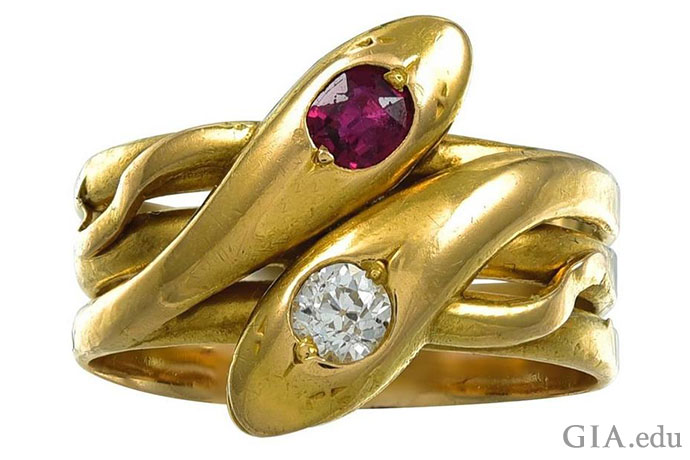
Two snakes are locked in an embrace in this Victorian-era (circa 1860) ring. An old European cut diamond and a ruby crown the heads of the snakes. Courtesy: 1stdibs.com

Edgy and Victorian-inspired, this platinum serpent style ring with heart shaped diamonds and melee borrows two signature design motifs from the period. Courtesy: Platinum Guild International, USA
Victorian Style Engagement Rings: Flower Power
In the Victorian lexicon of symbolism, the language of flowers blossomed as a rich tapestry of unspoken sentiments and hidden meanings. Within the verdant embrace of horticultural passion, each bloom unfurled its own poetic narrative, weaving a delicate dance of emotion and intention.
In the fragrant garden of Victorian sentiment, tulips emerged as heralds of passion, their vibrant hues igniting the flames of desire with fervent ardor. Bluebells, imbued with the gentle caress of kindness, whispered tales of compassion and empathy amidst their azure petals.
Myrtle, with its verdant leaves and delicate blooms, became an emblem of auspicious fortune and enduring love, casting its verdant spell upon the sacred bonds of matrimony. And amidst the lush tapestry of floral symbolism, red roses stood as veritable ambassadors of love’s passionate embrace, their scarlet petals ablaze with the ardor of devotion.
Yet amidst this symphony of floral eloquence, it was the purple violet that spoke loudest of all, its regal hues a testament to the profound depths of love’s contemplation. For in the language of flowers, the purple violet whispered secrets of hearts entwined in rapturous reverie, their thoughts forever occupied with the ineffable magic of love’s embrace.
Armed with the profound symbolism of these blossoms, the discerning connoisseur of Victorian elegance can now adorn their bespoke engagement ring with the delicate beauty of floral sentiment. Whether a single bloom or a lavish bouquet, each petal becomes a silent messenger of the heart’s deepest yearnings, weaving a tale of love and devotion that transcends the confines of spoken word.

A story of love, conveyed by gems.: Three flowers with ruby petals glow in this Victorian-era ring. Diamonds are the hearts of the blooms, and melee diamonds surround them in a play of light. Courtesy: LangAntiques.com

This modern engagement ring with its floral inspired design evokes the romantic Victorian period. Courtesy: Erika Winters Fine Jewelry, erikawinters.com
Victorian Style Engagement Rings: The Eternal Diamond
In the latter part of the 19th century, the unearthing of diamonds in South Africa revolutionized the landscape of luxury. Once a gem of exclusivity, diamonds became accessible to the burgeoning middle class. The allure of the old mine cut, characterized by its early cushion-shaped brilliance, adorned the jewelry of the elite during the early and mid-Victorian epochs. With its intricate facets—58 in total—this cut boasted a smaller table, larger culet, and heightened crown, bestowing upon it a distinctive allure. The dawn of the late Victorian era witnessed a transformation in diamond cutting, as innovations permitted the creation of round girdles, paving the way for the rise of the old European cut. This precursor to the contemporary round brilliant cut soon captured the hearts of discerning connoisseurs with its timeless elegance.
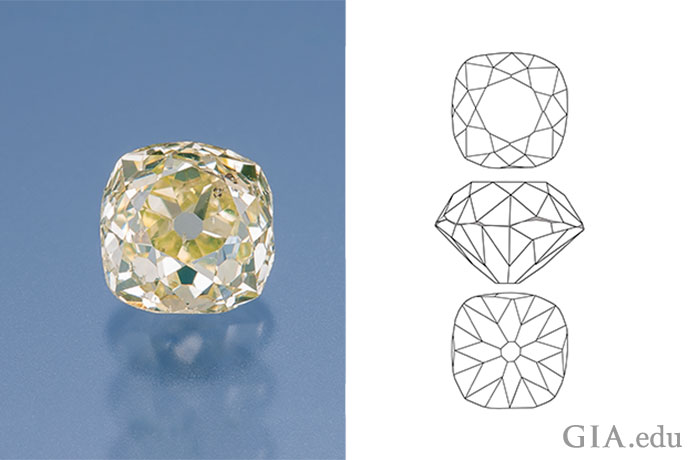
An old mine cut diamond has a distinctive look – especially compared to a round brilliant. Photo: Orasa Weldon/GIA
Throughout centuries, the unembellished elegance of a simple gold band reigned supreme as the quintessential choice for an engagement ring. Yet, as the Middle Ages unfolded, a new trend emerged—the advent of gem-set “betrothal rings.” This shift in fashion reached its zenith in 1477 when Archduke Maximilian of Austria presented Mary of Burgundy with a diamond-studded betrothal ring—a pivotal moment marking the inception of a new era in engagement ring design. To enhance the brilliance and sparkle of the increasingly favored faceted diamonds, the iconic Tiffany Setting—a revolutionary six-prong setting—was unveiled in 1886. Today, the allure of a diamond solitaire endures as a timeless emblem of commitment, evoking the opulence of a bygone era. Incorporating an old mine or similar cut diamond into your bespoke engagement ring pays homage to the enduring allure of Victorian sophistication.

The diamond solitaire ring has become a universal symbol of love. It has a timeless quality, as evidenced by this Victorian-era engagement ring featuring a 0.88 carat (ct) old mine cut diamond. Courtesy: TheRealReal.com
Victorian Style Engagement Rings: A Heart for Your Sweetheart
The emblematic heart, a timeless symbol of love and romance, held a profound allure for the discerning tastes of the Victorians, who were renowned for their penchant for sentimentalism. Revered then, as it is today, the heart motif serves as a poignant expression of affection, embodying the essence of enduring love. Incorporating a heart-shaped diamond, or any other gemstone, into your bespoke Victorian-style engagement ring effortlessly captures the essence of this cherished symbol. Alternatively, the convergence of two pear-shaped stones, delicately merging to form a singular heart, offers a subtly ingenious interpretation of this timeless emblem, evoking sentiments of profound adoration and devotion.
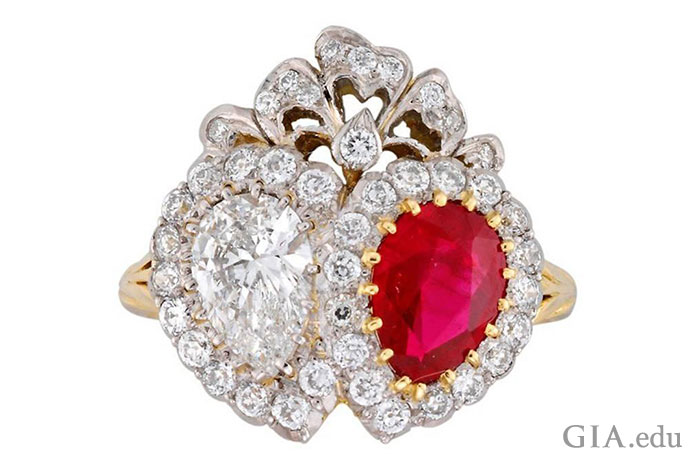
Two hearts beat as one in this Victorian-era ring, which features two stunning pear shapes, a 0.84 ct diamond and a 1.28 ct ruby. Courtesy: 1stdibs.com

Seeking inspiration for Victorian ring? Find heart! This modern heart-shaped yellow diamond ring features a signature motif of the Victorian era. Courtesy: 1stdibs.com
Victorian Style Engagement Rings: Crossover Rings
The crossover ring, a timeless symbol of unity and love, elegantly encircles the finger, its ends gracefully intertwining like two souls inextricably linked. Known as a “toi et moi” ring, echoing the sentiment of “you and me” in French, this romantic style flourished in the enchanting era of the 1890s and continues to captivate hearts today. Incorporating this evocative motif into your Victorian-inspired engagement ring design adds a touch of sentimental allure and timeless elegance.
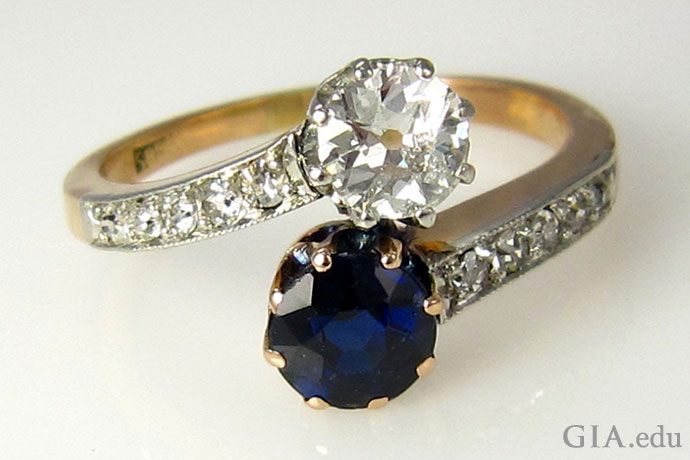
This Victorian-era (circa 1885) crossover ring, set with a sapphire and an old European cut diamond, celebrates two lives joined together in marriage. Courtesy: Treasurly by Dima



